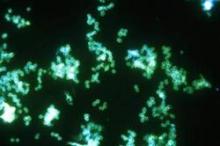Enhanced gonorrhea susceptibility to third-generation cephalosporin-class antibiotic agents such as injectable ceftriaxone and oral cefixime may have been temporary, according to a retrospective analysis published in the Nov. 3 issue of JAMA.
The findings of Dr. Robert D. Kirkcaldy at the Centers for Disease Control and Prevention’s Division of STD Prevention and his colleagues suggest that treatment-resistant gonorrhea is a challenge that clinicians will likely continue to confront (JAMA. 2015 Nov 3;314[17]:1869-71).
In 2012, the CDC updated its guidelines to recommend ceftriaxone-based combination therapy as the lone preferred treatment for gonorrhea, a common sexually transmitted disease. Subsequently, an apparent “halting of drift toward resistance” was observed by researchers from 2011 to 2013.
However, the 2014 numbers may indicate that the drift toward resistance has resumed. Utilizing data derived from the CDC’s Gonococcal Isolate Surveillance Project – a program that monitors antimicrobial susceptibility in men with gonorrhea treated at U.S. public clinics – investigators tracked recent gonococcal cephalosporin-susceptibility trends by measuring ceftriaxone and cefixime concentrations in 51,144 urethral isolates of consecutive men presenting with gonorrhea over an 8-year period (2006-2014).
Isolates with ceftriaxone minimum inhibitory concentrations of 0.125 mcg/mL or greater or cefixime minimum inhibitory concentrations of 0.25 mcg/mL or greater were defined as exhibiting reduced susceptibility.
Findings indicated that the percentage of isolates with reduced cefixime susceptibility increased from 0.1% in 2006 to 1.4% in 2011, then decreased to 0.4% in 2013 (P less than .001). In 2014, however, the percentage of isolates doubled to 0.8%.
Those trends were mirrored in the ceftriaxone concentration numbers, which also demonstrated a statistically significant elevation in minimum inhibitory concentrations from 2006 to 2011 (P less than .001), a decline from 2011 to 2013 (P less than .001), followed by a sharp increase from 2013 to 2014 (P = .13).
“The 2014 data suggest that improvements in susceptibility may be short lived,” the study authors noted. “The increased prevalence of reduced cefixime susceptibility in 2014 highlights the need to maintain surveillance, search for new therapeutics, and ensure that gonorrhea is treated according to the CDC’s guidelines.”
The CDC funds the Gonococcal Isolate Surveillance Project. Dr. Kirkcaldy reported no conflicts of interest.


